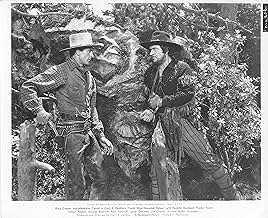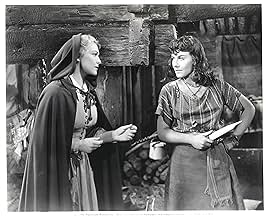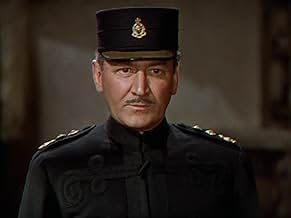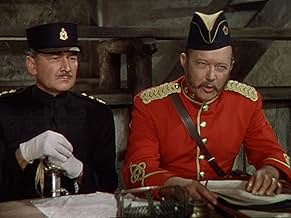In 1885, a Texas Ranger travels to Canada to arrest a trapper who's wanted for murder and who's stirring up the Natives in a rebellion against the Canadian government.In 1885, a Texas Ranger travels to Canada to arrest a trapper who's wanted for murder and who's stirring up the Natives in a rebellion against the Canadian government.In 1885, a Texas Ranger travels to Canada to arrest a trapper who's wanted for murder and who's stirring up the Natives in a rebellion against the Canadian government.
- Won 1 Oscar
- 4 wins & 4 nominations total
Featured reviews
When Cecil B. DeMille started filming Northwest Mounted Police, Joel McCrea was Texas Ranger Dusty Rivers (a cowboy name if there ever was one), but after a few scenes McCrea dropped out and Gary Cooper got to do his second of four DeMille features.
It was both DeMille and Cooper's first film in technicolor and when DeMille went in for technicolor we mean bright hues of every part of the rainbow. But back then color itself was a novelty so people liked seeing it. Northwest Mounted Police also won an Oscar for best editing. Taking home the prize was Anne Bauchens who edited every single DeMille film from back into the middle silent era. DeMille had it written into his contract at Paramount that he would not do a film unless Ms. Bauchens was available to be editor. He had many of the same folks on his various films, but only Ms. Bauchens rated that kind of treatment.
Michael Medved has Northwest Mounted Police listed among the fifty worst films of all time. It's not great, but it ain't as bad as all that. The Victorian DeMille type dialog is the main reason, but it is no more present here than in any of his other sound films.
Northwest Mounted Police takes place in the mid 1880s and concerns the famous 2nd Louis Riel Rebellion and the Duck Lake massacre of Royal Canadian Mounted Police in that conflict. Grafted on to that is the story of a Texas Ranger played by Gary Cooper who comes up to Canada with a warrant for one of Riel's confederates who killed a man in his state.
Of course Cooper gets himself mixed up in the politics of the area and also considerably mixed up with Maddeleine Carroll, much to the displeasure of her sweetheart Preston Foster, as stalwart a Mountie as you'll ever find this side of Nelson Eddy. That's a standard DeMille plot device, two men in heat over the heroine.
In some considerable heat himself is Robert Preston who is Carroll's brother also a Mountie. He's got it bad for Paulette Goddard a Meti who's got it real bad for Preston. In fact her little scheme concerning Preston is what drives the action of the film in the second half.
DeMille was never an actor's director or a writer's director. But he knew how to fill the screen and keep the action going. That he does in Northwest Mounted Police.
It was both DeMille and Cooper's first film in technicolor and when DeMille went in for technicolor we mean bright hues of every part of the rainbow. But back then color itself was a novelty so people liked seeing it. Northwest Mounted Police also won an Oscar for best editing. Taking home the prize was Anne Bauchens who edited every single DeMille film from back into the middle silent era. DeMille had it written into his contract at Paramount that he would not do a film unless Ms. Bauchens was available to be editor. He had many of the same folks on his various films, but only Ms. Bauchens rated that kind of treatment.
Michael Medved has Northwest Mounted Police listed among the fifty worst films of all time. It's not great, but it ain't as bad as all that. The Victorian DeMille type dialog is the main reason, but it is no more present here than in any of his other sound films.
Northwest Mounted Police takes place in the mid 1880s and concerns the famous 2nd Louis Riel Rebellion and the Duck Lake massacre of Royal Canadian Mounted Police in that conflict. Grafted on to that is the story of a Texas Ranger played by Gary Cooper who comes up to Canada with a warrant for one of Riel's confederates who killed a man in his state.
Of course Cooper gets himself mixed up in the politics of the area and also considerably mixed up with Maddeleine Carroll, much to the displeasure of her sweetheart Preston Foster, as stalwart a Mountie as you'll ever find this side of Nelson Eddy. That's a standard DeMille plot device, two men in heat over the heroine.
In some considerable heat himself is Robert Preston who is Carroll's brother also a Mountie. He's got it bad for Paulette Goddard a Meti who's got it real bad for Preston. In fact her little scheme concerning Preston is what drives the action of the film in the second half.
DeMille was never an actor's director or a writer's director. But he knew how to fill the screen and keep the action going. That he does in Northwest Mounted Police.
The master of spectacle doesn't let us down in that regard with his first movie shot in Technicolor.The action sequences are as exciting as in other De Mille spectacles but the hammy acting,the ridiculous dialog and slow pacing makes this a below par movie for De Mille. Gary Cooper and Madeleine Carroll look embarrassed throughout speaking those silly lines.Preston Foster as the third party of the love triangle has one of his more substantial parts in his career.But it is fun to watch Paulette Goddard's hilarious overacting.As her villainous father George Bancroft isn't far behind in that department.The best acting are provided by the two veterans Akim Tamiroff and Lynne Overman who provide some comic relief.The movie is beautiful to look at in bright colors and passes the afternoon quite painlessly.
One of several idiosyncratic inclusions in that silly book, 'The Fifty Worst Movies of All Time', DeMille's first film in full Technicolor is actually good fun; and adroitly exploits his new toy by filling the screen with Mounties' red uniforms (one of them worn by a fleetingly glimpsed young Robert Ryan).
Starring Gary Cooper as the delightfully named Dusty Rivers, the ladies comprise a rare appearance in colour by the blonde Madeleine Carroll (who describes Coop as "an angel in leather"), visually contrasted with dusky half-Indian wildcat Paulette Goddard (of whom Robert Preston snarls "If your neck wasn't so lovely I'd break it!!).
As usual in a late DeMille all the spectacular outdoor scenes are left in the hands of second-unit director Arthur Rossen; while veteran editor Anne Bauchen's ability to lick this all into coherent shape was acknowledged by the Academy with an Oscar.
Starring Gary Cooper as the delightfully named Dusty Rivers, the ladies comprise a rare appearance in colour by the blonde Madeleine Carroll (who describes Coop as "an angel in leather"), visually contrasted with dusky half-Indian wildcat Paulette Goddard (of whom Robert Preston snarls "If your neck wasn't so lovely I'd break it!!).
As usual in a late DeMille all the spectacular outdoor scenes are left in the hands of second-unit director Arthur Rossen; while veteran editor Anne Bauchen's ability to lick this all into coherent shape was acknowledged by the Academy with an Oscar.
You first have to understand that DeMille has taken considerable poetic licence, while using the story of the return of Louis Riel to Canada, and the subsequent Duck Lake massacre of a large unit of Mounties. Even the pronunciation by DeMille of the word "Metis" at the introduction to the movie is quite incorrect.
Fun to watch the fictional introduction of Gary Cooper as a Texas marshal travelling into Canada in pursuit of a Metis criminal.
Some good aspects of the film include the historical accuracy of the uniforms at that time... no wide brimmed hats... and the correctness of the name of the Mounties at that time. The only item of historical inaccuracy is the fur hats that DeMille has the Mounties wear. During the warmer weather they wore either a pill box hat or a white helmet. They did wear fur hats during the winter with their Buffalo hide coats, but DeMille did not like the design of any of the head wear that was part of the actual uniform, so he had this design made for the picture.
The two key bad guys are historical fact, although whether they acted as they are shown in the movie is another question. Whether there was a gatling gun at the Duck Lake massacre is another question the historians will have to answer.
Generally, a good romp... a great movie to sit back and watch with popcorn and a soft drink.
Fun to watch the fictional introduction of Gary Cooper as a Texas marshal travelling into Canada in pursuit of a Metis criminal.
Some good aspects of the film include the historical accuracy of the uniforms at that time... no wide brimmed hats... and the correctness of the name of the Mounties at that time. The only item of historical inaccuracy is the fur hats that DeMille has the Mounties wear. During the warmer weather they wore either a pill box hat or a white helmet. They did wear fur hats during the winter with their Buffalo hide coats, but DeMille did not like the design of any of the head wear that was part of the actual uniform, so he had this design made for the picture.
The two key bad guys are historical fact, although whether they acted as they are shown in the movie is another question. Whether there was a gatling gun at the Duck Lake massacre is another question the historians will have to answer.
Generally, a good romp... a great movie to sit back and watch with popcorn and a soft drink.
... but the director is Cecil B. DeMille, and given that DeMille helped build Paramount, it's not like the studio is going to deny even his worst impulses.
It's 1885, and the Metis (half-breed) people of western Canada are planning a rebellion, led by bad guys Corbeau (George Bancroft), Riel (Francis McDonald), and Duroc (Akim Tamiroff). Out to stop them are the stalwart men of the North West Mounted Police, led by the straight-backed Sgt. Jim Brett (Preston Foster). He bristles when he's forced to accept help from Texas Ranger Dusty Rivers (Gary Cooper), who has come north in search of a fugitive murderer. Both Brett and Rivers chase after angelic nurse April Logan (Madeleine Carroll). Meanwhile, young Mountie rake Ronnie Logan (Robert Preston) is conducting an illicit affair with half-breed wildcat Louvette (Paulette Goddard).
This is a big, loud mix of the dumb and the entertaining. It's bad but never boring, with outrageous characters sporting silly names ("Dusty Rivers"? Really?!?), tonally awkward scenes of slapstick comedy followed by people being shot in the head, and laughably misplaced romance. The gorgeous "Canadian" scenery was achieved primarily on LA soundstages, and the filmmakers never did make it to Canada, although there's some legitimate outdoor scenes shot in California state parks. However silly it all is, DeMille knew his formula well, as this ended up being Paramount's biggest hit of the year, as well as earning Oscar nominations for Best Score, Best Sound, Best Color Art Direction, and Best Color Cinematography, as well as winning for Best Editing.
Would it have gotten these accolades had the director NOT been De Mille? I doubt it.
It's 1885, and the Metis (half-breed) people of western Canada are planning a rebellion, led by bad guys Corbeau (George Bancroft), Riel (Francis McDonald), and Duroc (Akim Tamiroff). Out to stop them are the stalwart men of the North West Mounted Police, led by the straight-backed Sgt. Jim Brett (Preston Foster). He bristles when he's forced to accept help from Texas Ranger Dusty Rivers (Gary Cooper), who has come north in search of a fugitive murderer. Both Brett and Rivers chase after angelic nurse April Logan (Madeleine Carroll). Meanwhile, young Mountie rake Ronnie Logan (Robert Preston) is conducting an illicit affair with half-breed wildcat Louvette (Paulette Goddard).
This is a big, loud mix of the dumb and the entertaining. It's bad but never boring, with outrageous characters sporting silly names ("Dusty Rivers"? Really?!?), tonally awkward scenes of slapstick comedy followed by people being shot in the head, and laughably misplaced romance. The gorgeous "Canadian" scenery was achieved primarily on LA soundstages, and the filmmakers never did make it to Canada, although there's some legitimate outdoor scenes shot in California state parks. However silly it all is, DeMille knew his formula well, as this ended up being Paramount's biggest hit of the year, as well as earning Oscar nominations for Best Score, Best Sound, Best Color Art Direction, and Best Color Cinematography, as well as winning for Best Editing.
Would it have gotten these accolades had the director NOT been De Mille? I doubt it.
Did you know
- TriviaCecil B. DeMille initially thought Paulette Goddard was all wrong for the role of the half-breed Indian girl. Marlene Dietrich, Vivien Leigh, Katherine DeMille, Simone Simon, Anna Sten, Olympe Bradna, and Steffi Duna were considered for the part, but when Goddard showed up in his office in costume and make-up speaking pidgin English, he cast her.
- GoofsJust before heading out to find Corbeau, Rivers helps April up onto her wagon. A few minutes later we see her climb up again, on her own.
- Quotes
Dusty Rivers: Down where I come from we don't jump to conclusions. It's liable to be a feller's last jump.
- Alternate versionsThe UK DVD is cut by 6 secs with edits to cruel horsefalls.
- ConnectionsFeatured in Cecil B. DeMille: American Epic (2004)
- How long is North West Mounted Police?Powered by Alexa
Details
- Runtime2 hours 6 minutes
- Aspect ratio
- 1.37 : 1
Contribute to this page
Suggest an edit or add missing content

Top Gap
By what name was North West Mounted Police (1940) officially released in India in English?
Answer




































